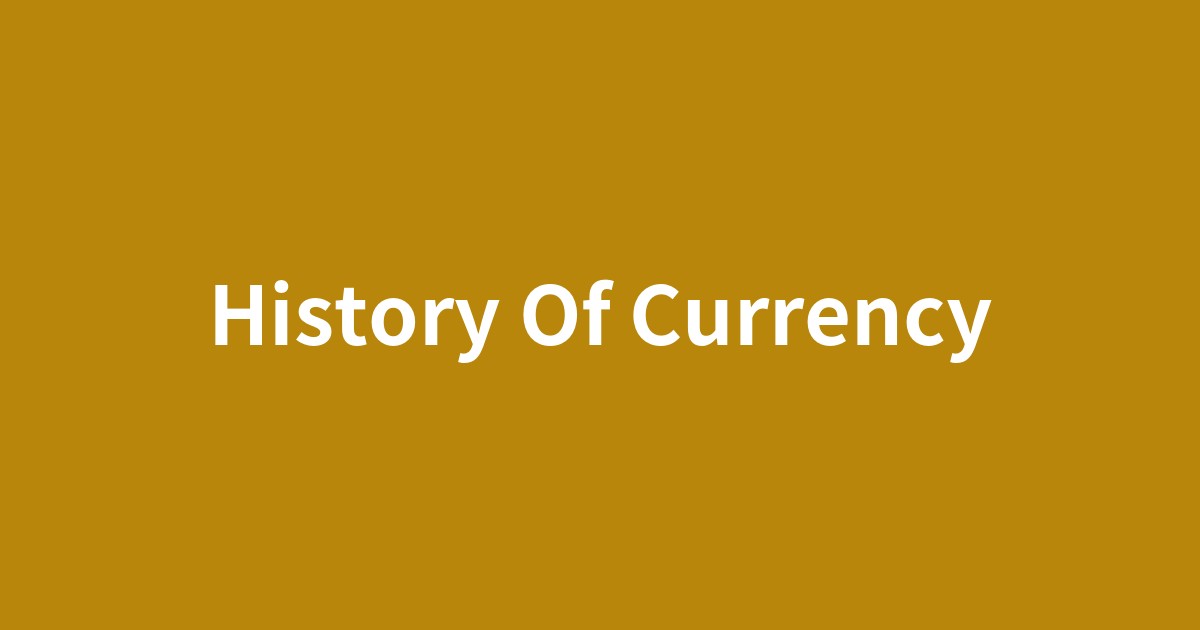このページは、歴史や文化の物語を楽しみながら、その文脈の中で重要な英単語を自然に学ぶための学習コンテンツです。各セクションの下にあるボタンで、いつでも日本語と英語を切り替えることができます。背景知識を日本語で学んだ後、英語の本文を読むことで、より深い理解と語彙力の向上を目指します。

物々交換から、金貨、紙幣、そして現代の仮想通貨へ。人々の「価値」の交換を支えてきた、currency(通貨)の壮大な進化の物語。
この記事で抑えるべきポイント
- ✓通貨の起源は、物々交換の不便さを解消するために生まれた「物品貨幣」にあり、その価値は社会的な合意に基づいていたこと。
- ✓金や銀などの貴金属が、その普遍的な価値から「金属貨幣」として広く採用され、広域での商業と帝国の発展を支えたという側面があること。
- ✓物理的な価値から、政府や銀行への「信用」を基盤とする「紙幣」へと移行したことで、経済活動が飛躍的に拡大したという見方があること。
- ✓デジタル技術の進化が、国家の信用とは異なるブロックチェーン技術を基盤とした「仮想通貨」を生み出し、価値のあり方を問い直していること。
通貨の歴史 ― 貝殻からビットコインまで
もし「お金」がなかったら、私たちはどうやってモノを手に入れるでしょうか?この素朴な疑問から、物々交換の不便さを乗り越えるために人類が生み出した偉大な発明、通貨(currency)の物語を始めます。本記事では、貝殻から始まり、金貨、紙幣、そして現代のビットコインに至るまで、通貨がどのように生まれ、社会をどう変えてきたのか、その壮大な進化の旅路をたどります。
The History of Currency: From Shells to Bitcoin
If there were no "money," how would we acquire things? This simple question marks the beginning of the story of currency, a great human invention created to overcome the inconveniences of barter. In this article, we will trace the grand evolutionary journey of currency, from its origins as seashells to gold coins, banknotes, and finally, modern Bitcoin, exploring how it was born and how it has transformed society.
「価値」の誕生 ― 物々交換から物品貨幣へ
通貨が存在しない時代、人々は物々交換(barter)によって必要なものを手に入れていました。しかし、この方法には「欲求の二重の一致」という大きな課題がありました。つまり、自分が欲しいものを持っている相手が、同時に自分の持っているものを欲しがっている、という状況が成立しなければ交換はできません。この不便さを解消するため、多くの人が共通して価値を認めるモノが、交換の仲立ちとして使われるようになりました。これが、それ自体に価値がある商品(commodity)を利用した、商品貨幣(commodity money)の始まりです。古代社会では、美しい貝殻や貴重な塩、あるいは加工された石などがその役割を担いました。なぜ特定のモノに価値が見出されたのか、その背景には、希少性だけでなく、文化的な意味合いや社会的な合意があったのです。
The Birth of "Value": From Barter to Commodity Money
In an era before currency, people obtained necessities through barter. However, this method had a major challenge known as the "double coincidence of wants." In other words, an exchange could only happen if the person who had what you wanted also wanted what you had. To solve this inconvenience, items that many people commonly recognized as valuable began to be used as a medium of exchange. This was the beginning of commodity money, which utilized a commodity with intrinsic value. In ancient societies, beautiful seashells, precious salt, or crafted stones played this role. The reason specific items were deemed valuable lies not only in their rarity but also in their cultural significance and social consensus.
普遍的な輝き ― 金属貨幣の時代
やがて、価値が劣化しにくく、分割や持ち運びが容易で、誰もがその価値を認めるという性質から、金や銀といった貴金属(precious metal)が通貨の主役となります。紀元前7世紀頃、現在のトルコ西部にあったリディア王国で、世界最古の鋳造貨幣の一つとされるエレクトロン貨が誕生しました。これは、国家がその重さと品質を保証し、硬貨を鋳造する(mint)という画期的な仕組みの始まりでした。権威による保証は通貨の信頼性を飛躍的に高め、広域での商業活動を活発化させ、古代帝国の経済的基盤を支える力となったのです。
Universal Brilliance: The Age of Metallic Currency
Eventually, precious metals like gold and silver became the leading form of currency due to their durability, divisibility, portability, and universally recognized value. Around the 7th century BC, in the Kingdom of Lydia in modern-day western Turkey, one of the world's earliest cast coins, the electrum coin, was created. This marked the beginning of a revolutionary system where the state guaranteed the weight and quality of coins and began to mint them. This official guarantee dramatically increased the reliability of currency, stimulated widespread commercial activity, and became a cornerstone of the economic foundation of ancient empires.
「信用」が価値を生む ― 紙幣と銀行の登場
金や銀は優れた通貨でしたが、大量に持ち運ぶには重く、盗難のリスクも伴いました。この問題を解決したのが、11世紀頃の中国、宋の時代に発明された世界初の紙幣「交子」です。商人が重い硬貨を預かる代わりに発行した預り証が、次第に人々の間で直接取引に使われるようになりました。この紙幣(banknote)の価値は、紙そのものではなく、発行者に対する信用(credit)に基づいています。当初は金と交換できることを保証する「金本位制」が主流でしたが、やがてその兌換義務もなくなり、国家の信用力だけで価値が保証される不換紙幣(fiat money)が現代の標準となりました。これは、通貨の価値が物理的な実体から、目に見えない「信用」という概念へ移行したことを象徴しています。
"Credit" Creates Value: The Emergence of Banknotes and Banks
While gold and silver were excellent forms of currency, they were heavy to carry in large quantities and posed a risk of theft. The solution to this problem was the world's first banknote, the "Jiaozi," invented in China during the Song Dynasty around the 11th century. Deposit receipts issued by merchants in exchange for heavy coins gradually came to be used directly in transactions among people. The value of this banknote is not based on the paper itself, but on the credit of the issuer. Initially, the "gold standard," which guaranteed exchange for gold, was mainstream. However, this convertibility was eventually abandoned, and fiat money, whose value is guaranteed solely by the credit of the state, became the modern standard. This symbolizes the shift in the value of currency from a physical entity to the intangible concept of "credit."
デジタルの潮流 ― 仮想通貨と未来の価値
インターネットが社会インフラとなった21世紀、通貨は再び大きな変革期を迎えています。電子マネーの普及を経て、国家や中央銀行といった中央管理者を介さずに価値を移転できる、暗号資産(cryptocurrency)が誕生しました。その代表格であるビットコインは、ブロックチェーン(blockchain)と呼ばれる分散型台帳技術を基盤としています。これは、取引の記録をネットワーク上の参加者全員で共有・管理することで、改ざんを極めて困難にし、国家とは異なる新しい形の「信用」を創り出す試みです。その革新的な可能性に期待が集まる一方で、激しい価格変動や法規制、環境負荷といった課題も指摘されており、その未来はまだ定まっていません。
The Digital Tide: Cryptocurrency and the Future of Value
In the 21st century, as the internet became a social infrastructure, currency is once again undergoing a major transformation. Following the spread of electronic money, cryptocurrency was born, enabling the transfer of value without intermediaries like states or central banks. Its most prominent example, Bitcoin, is based on a distributed ledger technology called blockchain. This is an attempt to create a new form of "credit" different from that of the state by sharing and managing transaction records among all network participants, making them extremely difficult to tamper with. While there is great hope for its innovative potential, it also faces challenges such as high price volatility, legal regulations, and environmental impact, and its future remains uncertain.
結論
通貨の歴史を振り返ると、それは人間社会が「価値」をどのように定義し、「信用」をいかに築いてきたかの物語であることがわかります。貝殻からビットコインまで、その形は劇的に変化しましたが、人々の交換を円滑にし、経済活動を支えるという本質は不変です。私たちが日々何気なく使っている「お金」の背景にある壮大な歴史は、これからの社会で「価値」の交換がどう進化していくかを考える、一つの豊かな視点を与えてくれるでしょう。
Conclusion
Looking back at the history of currency, we see that it is a story of how human society has defined "value" and built "credit." From seashells to Bitcoin, its form has changed dramatically, but its essential function of facilitating exchange and supporting economic activity remains unchanged. The grand history behind the "money" we use casually every day provides a rich perspective for considering how the exchange of "value" will evolve in the society of the future.
テーマを理解する重要単語
commodity
それ自体に価値がある「商品」や「産物」を指します。この記事では、初期の通貨形態である「commodity money(商品貨幣)」の概念を理解するために必須です。塩や貝殻などがなぜ通貨として機能したのか、つまりモノそのものが価値を持つという通貨の原初の形を学ぶ上で、中心的な役割を果たす単語です。
文脈での用例:
Oil is one of the most valuable commodities in the world.
石油は世界で最も価値のある商品の一つです。
credit
「信用」を意味し、本記事の核心テーマの一つです。物理的な価値を持つ金属貨幣から、発行者への「信用」のみを価値の源泉とする紙幣への移行を説明する上で不可欠な概念です。現代の不換紙幣や、さらには暗号資産における新しい信用の形まで、通貨の進化の根底にある「目に見えない価値」を理解するための鍵となります。
文脈での用例:
The bank extended a large line of credit to the company.
その銀行は、その会社に多額の信用貸付枠を提供した。
intrinsic
「本来備わっている、本質的な」という意味の形容詞です。記事では「intrinsic value(本質的価値)」という形で、商品貨幣がなぜ価値を持ったのかを説明する際に使われます。金や銀がそれ自体に価値を持つ一方、現代の紙幣にはないこの性質を理解することは、通貨の価値の源泉がどう変化してきたかを捉える上で極めて重要です。
文脈での用例:
The intrinsic value of a handmade craft is often higher than its price.
手作りの工芸品の本質的な価値は、しばしばその価格よりも高いです。
currency
記事全体の主題であり、「通貨」を意味する最も基本的な単語です。貝殻からビットコインまで、時代と共に形を変える価値の交換媒体を指します。この単語を核として、物々交換から現代の暗号資産に至るまでの通貨の壮大な進化の物語が展開されており、記事の全体像を理解する上で不可欠です。
文脈での用例:
The Japanese Yen is a stable currency in the global market.
日本円は世界市場で安定した通貨です。
mint
「(貨幣を)鋳造する」という意味の動詞です。この記事では、リディア王国が国家として硬貨の品質を保証し、鋳造を始めた画期的な出来事を説明する箇所で登場します。国家権力が通貨の信頼性を担保するという、経済史における大きな転換点を象徴する単語であり、金属貨幣の時代を理解する上で欠かせません。
文脈での用例:
The government has decided to mint a new series of coins.
政府は新しいシリーズの硬貨を鋳造することを決定しました。
intermediary
「仲介者」を意味し、この記事では国家や中央銀行といった伝統的な金融システムの中心的存在を指して使われています。暗号資産が「intermediaries」を介さずに価値を移転できる、という点がその革新性として強調されています。中央集権的なシステムと、ブロックチェーンが可能にする分散型システムとの対比を理解する上で重要な概念です。
文脈での用例:
The bank acted as an intermediary between the buyer and the seller.
その銀行は買い手と売り手の間の仲介者として機能した。
barter
通貨が誕生する前の経済システム「物々交換」を指します。記事では、この方法が持つ「欲求の二重の一致」という不便さを乗り越えるために通貨が発明された、という歴史の出発点として登場します。この単語は、通貨がなぜ人類にとって偉大な発明であったのかを理解するための重要な鍵となります。
文脈での用例:
In ancient times, people used to barter goods for services.
古代、人々は品物とサービスを物々交換していました。
precious metal
金や銀に代表される「貴金属」を指す言葉です。記事では、商品貨幣から、より普遍的な価値を持つ金属貨幣への移行を説明する上で中心的な役割を果たします。その耐久性、希少性、分割の容易さから通貨の主役となった歴史的背景を理解することで、なぜ長きにわたり人類が金や銀に価値を見出してきたのかが分かります。
文脈での用例:
Gold and platinum are considered precious metals.
金やプラチナは貴金属と見なされています。
banknote
日本語の「紙幣」にあたる単語です。記事では、中国で発明された世界初の紙幣「交子」から現代の紙幣まで、通貨史における大きな飛躍を象徴する存在として登場します。重い硬貨を持ち運ぶ不便さを解消し、価値の根拠を物理的なモノから「信用」へと移行させた、この発明の重要性を理解する上で必須の単語です。
文脈での用例:
He pulled a fifty-dollar banknote from his wallet.
彼は財布から50ドル紙幣を一枚取り出した。
fiat money
金などとの交換が保証されていない「不換紙幣」を指す専門用語です。'fiat'はラテン語で「そうあれ」という命令を意味します。この記事では、金本位制が終わり、国家の信用力だけで価値が保証される現代の標準的な通貨形態として解説されています。通貨の価値が完全に抽象的な概念へ移行したことを示す重要なキーワードです。
文脈での用例:
The U.S. dollar is a form of fiat money, backed only by the trust in the government.
米ドルは、政府への信頼のみに裏付けられた不換紙幣の一形態です。
cryptocurrency
通貨の歴史の最先端である「暗号資産」を指します。国家や中央銀行を介さずに価値を移転できるという、通貨のあり方を根本から変える可能性を秘めた技術です。この記事の現代パートを理解する上で中心となる単語であり、ビットコインに代表される新しい価値の交換手段が直面する期待と課題を学ぶ上で欠かせません。
文脈での用例:
Bitcoin is the most famous example of a cryptocurrency.
ビットコインは最も有名な暗号資産の例です。
blockchain
ビットコインなど暗号資産の基盤となる「分散型台帳技術」です。取引記録を鎖(チェーン)のようにつなぎ、参加者全員で共有することで改ざんを困難にします。この記事では、国家による保証とは異なる、新しい形の「信用」を創り出す技術として紹介されています。現代の通貨革命を理解するための最重要技術用語です。
文脈での用例:
Blockchain technology provides a secure and transparent way to record transactions.
ブロックチェーン技術は、取引を記録するための安全で透明性の高い方法を提供します。